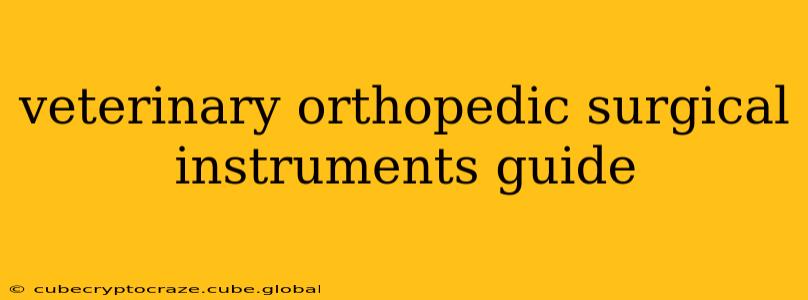Veterinary orthopedic surgery requires a specialized set of instruments to perform precise and delicate procedures. This guide provides a comprehensive overview of common instruments used in veterinary orthopedic surgery, categorized for ease of understanding. Understanding these instruments is crucial for veterinary technicians and anyone involved in the surgical process. This guide will delve into the specifics of each instrument type, highlighting their uses and importance.
What are the Different Types of Veterinary Orthopedic Surgical Instruments?
Veterinary orthopedic surgical instruments can be broadly categorized into several groups based on their function. These categories often overlap, with some instruments having multiple uses.
1. Bone Holding Instruments:
These instruments securely hold bone fragments during procedures like fracture repair. Examples include:
- Bone Holding Forceps: These come in various sizes and designs, offering secure grips on bone fragments of different shapes and sizes. They are essential for maintaining bone alignment during fixation.
- Reduction Forceps: These specialized forceps aid in the realignment of fractured bones before fixation. Their design facilitates precise manipulation and reduction.
- Bone Clamps: These provide strong fixation for larger bone fragments, ensuring stability during the surgical procedure.
2. Bone Cutting Instruments:
These instruments are used to cut, shape, and prepare bone for procedures like osteotomies and implant placement. Examples include:
- Osteotomes: These chisels are used to cut or shape bone. They come in various sizes and shapes, catering to different surgical needs.
- Saws: These instruments, such as reciprocating saws and oscillating saws, are used for cutting bone. They offer precise cuts and are invaluable for complex procedures.
- Bone Reamers: These instruments are used to enlarge or smooth bone canals, often used during implant placement.
3. Implant Placement Instruments:
These instruments facilitate the accurate placement and fixation of orthopedic implants such as plates, screws, pins, and intramedullary nails.
- Drill Bits: These are used to create pilot holes for screws and other implants, ensuring proper placement and preventing bone fracturing.
- Screw Drivers: These instruments precisely insert and tighten screws used in bone plate fixation.
- Implant Insertion Instruments: Specific instruments are designed for the insertion and placement of various types of implants.
4. Soft Tissue Instruments:
While focusing on bone, orthopedic surgeries also involve significant soft tissue manipulation. These instruments include:
- Scalpels: Used for incision and dissection of soft tissue.
- Scissors: Various types of scissors are used for precise cutting and dissection.
- Retractors: These instruments help to retract soft tissue, exposing the surgical site for better visualization.
- Suture Instruments: These include needle holders, forceps, and scissors, essential for closing incisions and repairing damaged soft tissue.
5. Measuring and Guiding Instruments:
Precision is paramount in orthopedic surgery. These tools aid in accurate measurements and implant placement.
- Measuring Devices: These tools accurately measure bone fragments and ensure proper implant sizing.
- Templates and Guides: These tools ensure precise placement of implants, minimizing the risk of complications.
What are the essential considerations when selecting veterinary orthopedic surgical instruments?
Selecting the right instruments for a specific procedure depends on several factors, including:
- The size and breed of the animal: Instrument sizes must be appropriate for the patient.
- The type of fracture or injury: Different instruments are needed for different injuries.
- The surgical technique employed: The chosen surgical technique will determine the specific instruments required.
- The surgeon's preference: Surgeons often develop preferences for certain instrument designs and manufacturers.
What are some common materials used in veterinary orthopedic surgical instruments?
Veterinary orthopedic surgical instruments are typically made from high-quality stainless steel for durability, resistance to corrosion, and ease of sterilization. Some specialized instruments may utilize other materials for specific properties, such as titanium for lightweight strength.
How are veterinary orthopedic surgical instruments sterilized?
Sterilization is crucial to prevent surgical site infections. Autoclaving is the most common method used to sterilize veterinary orthopedic surgical instruments. Strict adherence to sterilization protocols is mandatory.
This guide provides a foundational understanding of the various instruments used in veterinary orthopedic surgery. Remember, this is not an exhaustive list and specific instruments may vary depending on the complexity of the procedure and the surgeon's preference. Consult with veterinary surgeons and experienced technicians for more in-depth knowledge and practical application.
